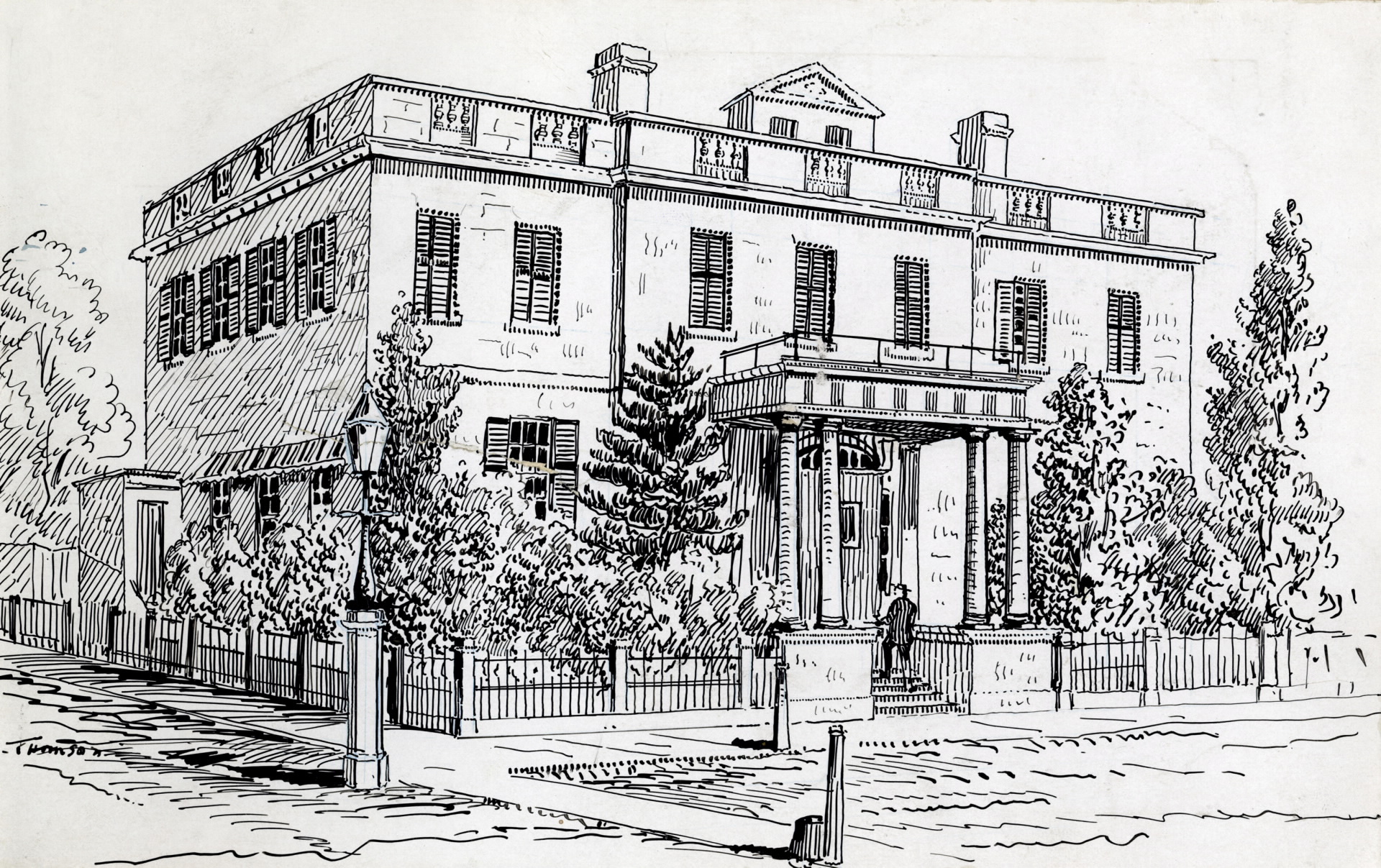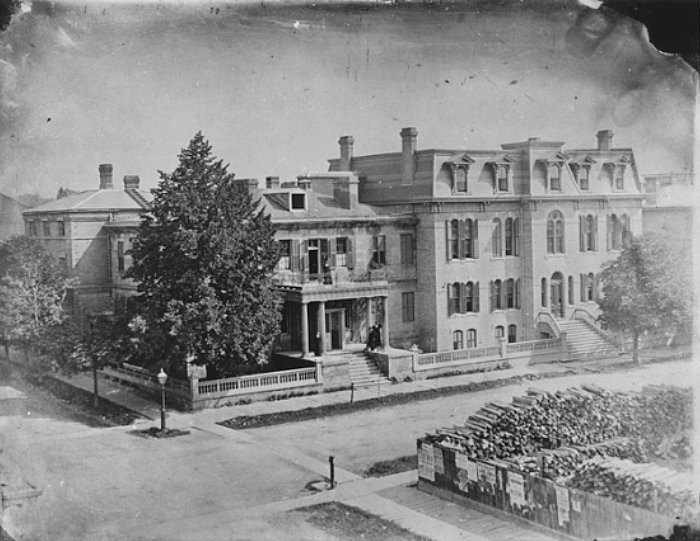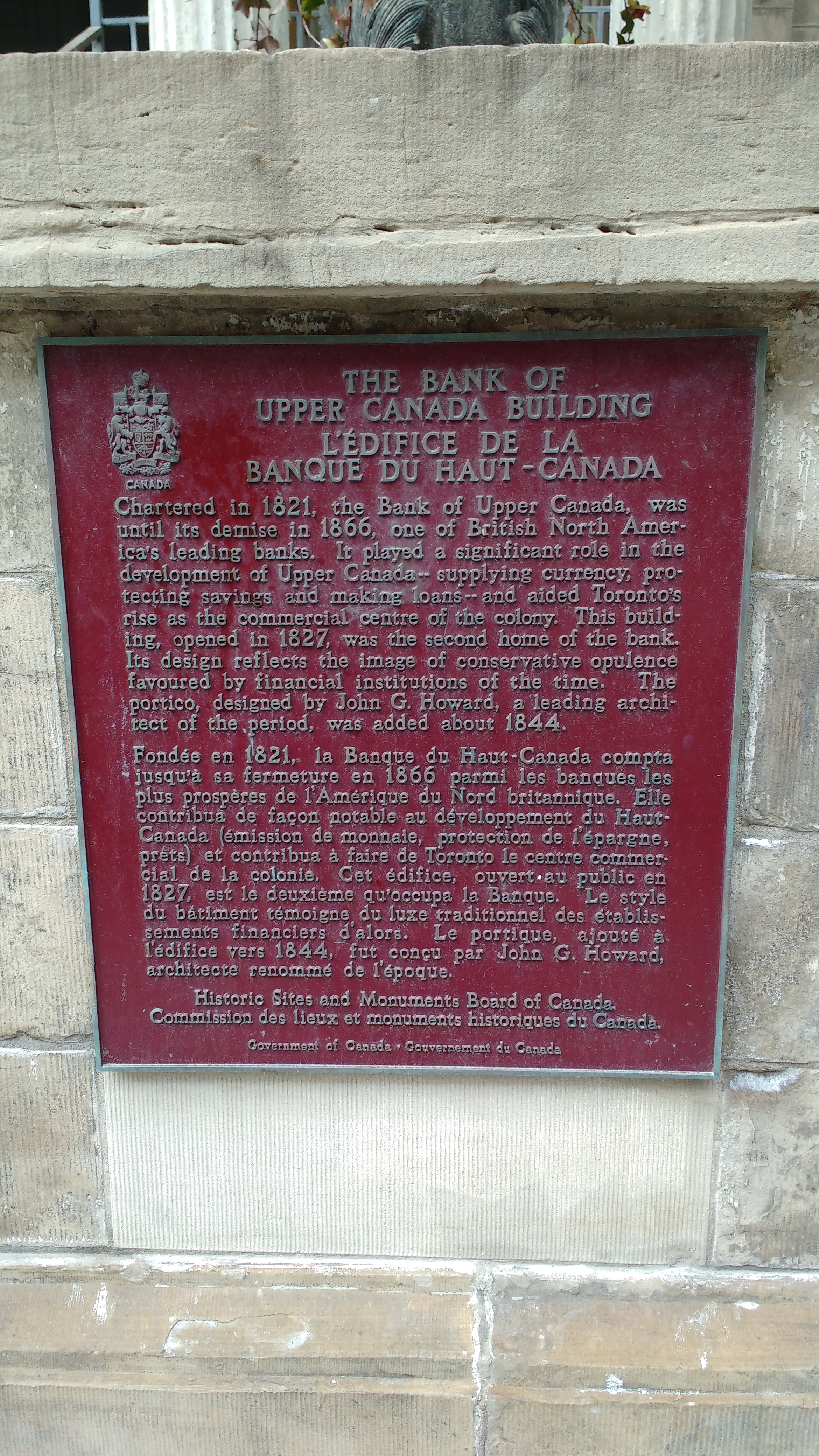Bank Of Upper Canada Building on:
[Wikipedia]
[Google]
[Amazon]
The Bank of Upper Canada Building is a former bank building in
 The
The
 The property was sold in 1870 to the De La Salle Brothers. In 1871, a Roman Catholic boys' school (De La Salle Institute, later known as De La Salle College) was built next door at 258 Adelaide Street, adjoining the bank building. In 1874, the school also bought 264 Adelaide Street, which had been built for the town's postmaster and that dates to 1834.
The Brothers sold the three buildings to the Catholic School Board in 1884 but used them rent-free after the sale. After the school started offering secondary classes, it took over the bank building as well. The school left the site in 1913.
Subsequently, the building was used for various purposes, including a meat processing plant, a recruitment centre during World War I, and industrial uses by Christie, Brown and Company and the United Farmers' Co-Operative Co. (UFC). In 1921, Christie Brown bought the building from the School Board, mostly for the rear yard property. The buildings were rented out to various commercial and industrial tenants, including a jeweler, machine shops and the Imperial Oil graphics department, which made Esso signs in the basement.
In 1925, the UFC bought the building to use as its head office. The bank building was used for offices, while the De La Salle and Post Office buildings were used for food storage. In 1926, the UFC built a three-storey addition to the north. The UFC sold the building in 1956.
The property was sold in 1870 to the De La Salle Brothers. In 1871, a Roman Catholic boys' school (De La Salle Institute, later known as De La Salle College) was built next door at 258 Adelaide Street, adjoining the bank building. In 1874, the school also bought 264 Adelaide Street, which had been built for the town's postmaster and that dates to 1834.
The Brothers sold the three buildings to the Catholic School Board in 1884 but used them rent-free after the sale. After the school started offering secondary classes, it took over the bank building as well. The school left the site in 1913.
Subsequently, the building was used for various purposes, including a meat processing plant, a recruitment centre during World War I, and industrial uses by Christie, Brown and Company and the United Farmers' Co-Operative Co. (UFC). In 1921, Christie Brown bought the building from the School Board, mostly for the rear yard property. The buildings were rented out to various commercial and industrial tenants, including a jeweler, machine shops and the Imperial Oil graphics department, which made Esso signs in the basement.
In 1925, the UFC bought the building to use as its head office. The bank building was used for offices, while the De La Salle and Post Office buildings were used for food storage. In 1926, the UFC built a three-storey addition to the north. The UFC sold the building in 1956.
 The buildings were leased until 1971, when they were closed up – slated for demolition and redevelopment – and fell into decay. In 1978, a fire destroyed much of the roof, but by then the site had been declared a National Historic Site and an Ontario listed heritage building, and it had attracted the attention of lawyer Sheldon J. Godfrey and his wife Judith. The couple purchased the three buildings and supervised their restoration to completion in 1982. The building, along with the former college, is used today for commercial office space. As of October 2013, the property was being used by tech firm Myplanet, among others.
The buildings were leased until 1971, when they were closed up – slated for demolition and redevelopment – and fell into decay. In 1978, a fire destroyed much of the roof, but by then the site had been declared a National Historic Site and an Ontario listed heritage building, and it had attracted the attention of lawyer Sheldon J. Godfrey and his wife Judith. The couple purchased the three buildings and supervised their restoration to completion in 1982. The building, along with the former college, is used today for commercial office space. As of October 2013, the property was being used by tech firm Myplanet, among others.

 The building is designated under Part IV of the '' Ontario Heritage Act'', since 1975. Per the City's designation: "The Bank of Upper Canada, 252 Adelaide Street East (formerly 28 Duke Street) at George Street (NE), 1830, perhaps by W.W. Baldwin, additions c.1850, additions 1871 for De La Salle College, is designated to be of architectural value as being the home of the first major bank associated with the development of the Province of Ontario, and is probably the oldest surviving building built as a bank in Canada. The building is also important as a very early, exceptionally well-designed and quite well preserved late Georgian stone-built structure in the neo-Classical style. It is, moreover, the last remaining building of architectural importance in the Old Town of York area, where it and the later additions, especially those for De La Salle College, give it a dominance in the streetscape at Adelaide and George Street."
The building is designated under Part IV of the '' Ontario Heritage Act'', since 1975. Per the City's designation: "The Bank of Upper Canada, 252 Adelaide Street East (formerly 28 Duke Street) at George Street (NE), 1830, perhaps by W.W. Baldwin, additions c.1850, additions 1871 for De La Salle College, is designated to be of architectural value as being the home of the first major bank associated with the development of the Province of Ontario, and is probably the oldest surviving building built as a bank in Canada. The building is also important as a very early, exceptionally well-designed and quite well preserved late Georgian stone-built structure in the neo-Classical style. It is, moreover, the last remaining building of architectural importance in the Old Town of York area, where it and the later additions, especially those for De La Salle College, give it a dominance in the streetscape at Adelaide and George Street."
252–264 Adelaide Street East
– Allied Properties REIT
{{coord, 43, 39, 06.54, N, 79, 22, 15.5, W, region:CA-ON_type:landmark_scale:2500, display=title Buildings and structures in Toronto Historic bank buildings in Canada National Historic Sites in Ontario Commercial buildings completed in 1825 Burned buildings and structures in Canada City of Toronto Heritage Properties
Toronto
Toronto ( ; or ) is the capital city of the Canadian province of Ontario. With a recorded population of 2,794,356 in 2021, it is the most populous city in Canada and the fourth most populous city in North America. The city is the anch ...
, Ontario, Canada, and one of the few remaining buildings in Toronto that predate the 1834 incorporation of the city. It is located at 252 Adelaide Street East (originally 28 Duke Street), in the Old Town district. Opened in 1827, in what was then the town of York
York is a cathedral city with Roman origins, sited at the confluence of the rivers Ouse and Foss in North Yorkshire, England. It is the historic county town of Yorkshire. The city has many historic buildings and other structures, such as a ...
, the building housed the Bank of Upper Canada
The Bank of Upper Canada was established in 1821 under a charter granted by the legislature of Upper Canada in 1819 to a group of Kingston merchants. The charter was appropriated by the more influential Executive Councillors to the Lt. Governor, t ...
until the bank's collapse in 1866. It was then used for school purposes and later for various commercial and industrial purposes before being restored in 1982 as commercial office space. The building has been designated a National Historic Site of Canada
National Historic Sites of Canada (french: Lieux historiques nationaux du Canada) are places that have been designated by the federal Minister of the Environment on the advice of the Historic Sites and Monuments Board of Canada (HSMBC), as being ...
since 1977.
Description
 The
The limestone
Limestone ( calcium carbonate ) is a type of carbonate sedimentary rock which is the main source of the material lime. It is composed mostly of the minerals calcite and aragonite, which are different crystal forms of . Limestone forms whe ...
-clad building was completed in 1827 and originally had two storeys with a flat roof. The design is attributed to William Warren Baldwin
William Warren Baldwin (April 25, 1775 – January 8, 1844) was a doctor, businessman, lawyer, judge, architect and reform politician in Upper Canada. He, and his son Robert Baldwin, are recognized for having introduced the concept of "respon ...
, but it may have been designed by Francis Hall. The Doric portico, designed by John George Howard
John George Howard (born John Corby; July 27, 1803 – February 3, 1890) was the official surveyor and civil engineer for the government of Toronto in Upper Canada and later Canada. He was also the first professional architect in Toronto. He d ...
, was added in 1843.
Sometime after 1859, a new roof with dormers was added. In 1876, a mansard roof in the Second Empire Second Empire may refer to:
* Second British Empire, used by some historians to describe the British Empire after 1783
* Second Bulgarian Empire (1185–1396)
* Second French Empire (1852–1870)
** Second Empire architecture, an architectural styl ...
style was added by the De La Salle Institute. As well, the building has been extended twice to the north, along George Street.
Stone Kohn Architects are responsible for the 1982 restoration design. The building is adjoined to the former De La Salle Institute building (1871) and Toronto's first post office building (1834) along Adelaide Street.
History
The bank had opened in 1821 in a nearby store and then moved to the new building in 1827. At that time, it was one of the few stone buildings in York and was the town's first bank building. During the 1837 rebellion,William Lyon Mackenzie
William Lyon Mackenzie (March12, 1795 August28, 1861) was a Scottish Canadian-American journalist and politician. He founded newspapers critical of the Family Compact, a term used to identify elite members of Upper Canada. He represented Yor ...
and the Reformers marched down Yonge Street
Yonge Street (; pronounced "young") is a major arterial route in the Canadian province of Ontario connecting the shores of Lake Ontario in Toronto to Lake Simcoe, a gateway to the Upper Great Lakes.
Once the southernmost leg of provincial H ...
with a plan to attack this building and steal the gold stored within – unsuccessfully. In 1851, the bank built an addition to the rear. The bank itself failed in 1866 and was put in receivership.
 The property was sold in 1870 to the De La Salle Brothers. In 1871, a Roman Catholic boys' school (De La Salle Institute, later known as De La Salle College) was built next door at 258 Adelaide Street, adjoining the bank building. In 1874, the school also bought 264 Adelaide Street, which had been built for the town's postmaster and that dates to 1834.
The Brothers sold the three buildings to the Catholic School Board in 1884 but used them rent-free after the sale. After the school started offering secondary classes, it took over the bank building as well. The school left the site in 1913.
Subsequently, the building was used for various purposes, including a meat processing plant, a recruitment centre during World War I, and industrial uses by Christie, Brown and Company and the United Farmers' Co-Operative Co. (UFC). In 1921, Christie Brown bought the building from the School Board, mostly for the rear yard property. The buildings were rented out to various commercial and industrial tenants, including a jeweler, machine shops and the Imperial Oil graphics department, which made Esso signs in the basement.
In 1925, the UFC bought the building to use as its head office. The bank building was used for offices, while the De La Salle and Post Office buildings were used for food storage. In 1926, the UFC built a three-storey addition to the north. The UFC sold the building in 1956.
The property was sold in 1870 to the De La Salle Brothers. In 1871, a Roman Catholic boys' school (De La Salle Institute, later known as De La Salle College) was built next door at 258 Adelaide Street, adjoining the bank building. In 1874, the school also bought 264 Adelaide Street, which had been built for the town's postmaster and that dates to 1834.
The Brothers sold the three buildings to the Catholic School Board in 1884 but used them rent-free after the sale. After the school started offering secondary classes, it took over the bank building as well. The school left the site in 1913.
Subsequently, the building was used for various purposes, including a meat processing plant, a recruitment centre during World War I, and industrial uses by Christie, Brown and Company and the United Farmers' Co-Operative Co. (UFC). In 1921, Christie Brown bought the building from the School Board, mostly for the rear yard property. The buildings were rented out to various commercial and industrial tenants, including a jeweler, machine shops and the Imperial Oil graphics department, which made Esso signs in the basement.
In 1925, the UFC bought the building to use as its head office. The bank building was used for offices, while the De La Salle and Post Office buildings were used for food storage. In 1926, the UFC built a three-storey addition to the north. The UFC sold the building in 1956.
 The buildings were leased until 1971, when they were closed up – slated for demolition and redevelopment – and fell into decay. In 1978, a fire destroyed much of the roof, but by then the site had been declared a National Historic Site and an Ontario listed heritage building, and it had attracted the attention of lawyer Sheldon J. Godfrey and his wife Judith. The couple purchased the three buildings and supervised their restoration to completion in 1982. The building, along with the former college, is used today for commercial office space. As of October 2013, the property was being used by tech firm Myplanet, among others.
The buildings were leased until 1971, when they were closed up – slated for demolition and redevelopment – and fell into decay. In 1978, a fire destroyed much of the roof, but by then the site had been declared a National Historic Site and an Ontario listed heritage building, and it had attracted the attention of lawyer Sheldon J. Godfrey and his wife Judith. The couple purchased the three buildings and supervised their restoration to completion in 1982. The building, along with the former college, is used today for commercial office space. As of October 2013, the property was being used by tech firm Myplanet, among others.

 The building is designated under Part IV of the '' Ontario Heritage Act'', since 1975. Per the City's designation: "The Bank of Upper Canada, 252 Adelaide Street East (formerly 28 Duke Street) at George Street (NE), 1830, perhaps by W.W. Baldwin, additions c.1850, additions 1871 for De La Salle College, is designated to be of architectural value as being the home of the first major bank associated with the development of the Province of Ontario, and is probably the oldest surviving building built as a bank in Canada. The building is also important as a very early, exceptionally well-designed and quite well preserved late Georgian stone-built structure in the neo-Classical style. It is, moreover, the last remaining building of architectural importance in the Old Town of York area, where it and the later additions, especially those for De La Salle College, give it a dominance in the streetscape at Adelaide and George Street."
The building is designated under Part IV of the '' Ontario Heritage Act'', since 1975. Per the City's designation: "The Bank of Upper Canada, 252 Adelaide Street East (formerly 28 Duke Street) at George Street (NE), 1830, perhaps by W.W. Baldwin, additions c.1850, additions 1871 for De La Salle College, is designated to be of architectural value as being the home of the first major bank associated with the development of the Province of Ontario, and is probably the oldest surviving building built as a bank in Canada. The building is also important as a very early, exceptionally well-designed and quite well preserved late Georgian stone-built structure in the neo-Classical style. It is, moreover, the last remaining building of architectural importance in the Old Town of York area, where it and the later additions, especially those for De La Salle College, give it a dominance in the streetscape at Adelaide and George Street."
See also
*List of historic places in Toronto
Toronto, Ontario, Canada, has several federal, provincial, or municipal historic places entered on the Canadian Register of Historic Places
The Canadian Register of Historic Places (CRHP; french: Le Répertoire canadien des lieux patrimoniau ...
*List of oldest buildings and structures in Toronto
This is a list of the oldest buildings and structures in Toronto, that were constructed before 1920. The history of Toronto dates back to Indigenous settlements in the region approximately 12,000 years ago. However, the oldest standing structures ...
References
Bibliography
*External links
252–264 Adelaide Street East
– Allied Properties REIT
{{coord, 43, 39, 06.54, N, 79, 22, 15.5, W, region:CA-ON_type:landmark_scale:2500, display=title Buildings and structures in Toronto Historic bank buildings in Canada National Historic Sites in Ontario Commercial buildings completed in 1825 Burned buildings and structures in Canada City of Toronto Heritage Properties